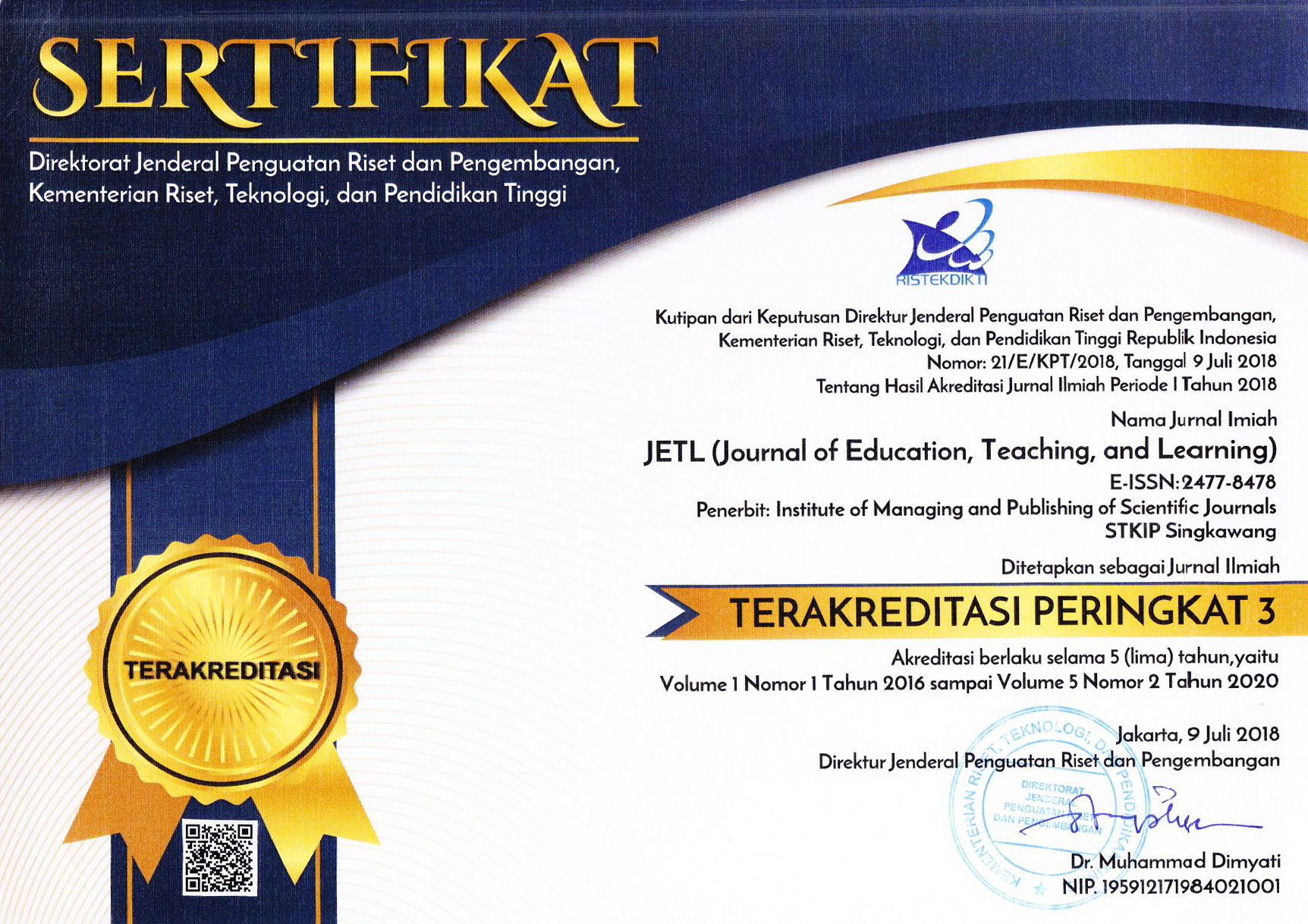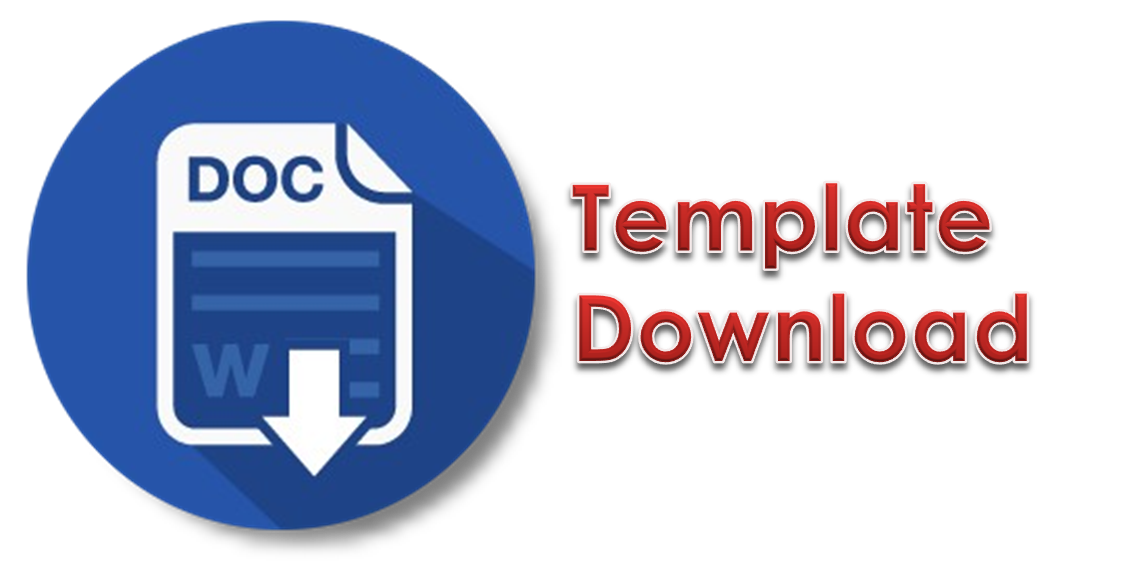Students’ Perceptions of Flipped Approach in EFL Classroom: A Survey Research
Abstract
This research investigated the implementation of Flipped Approach in EFL classroom with the implementation of the E-learning platform. The participants were 42 sophomore English majors of Advanced Paragraph Writing class at Jember University. A within-subjects research design exposed all participants to have Writing Class by flipped learning and to use the E-learning platform. A one-shot survey design was used in this research by distributing two questionnaires “Perception of Flipped Learning Experience” and “Technology Acceptance Model” and doing the in-class observations as “Flipped Note” to collect the data. Data were analyzed quantitatively through SPSS 16.0 by applying the formula of Descriptive Statistics. The results of this research revealed that the implementation of the flipped approach in the classroom: (1) motivated the students in learning the materials, (2) enhanced the students’ knowledge, (3) and engaged them more in the learning tasks. They explained that the flipped approach gave them a new experience in language learning processes, in which they learned the materials before coming to the classroom so that they could criticize the materials. This way of learning aligns with the idea of student-centred learning. It is notable, however, that the students who did not learn the materials yet, could not criticize the materials and could not reach better outcomes in flipped classroom Moreover, the use of E-learning in the flipped classroom gave the students beneficial outcomes in the learning processes. Students revealed on the Technology Acceptance Model questionnaire that E-learning facilitates them properly, and they wanted to look forward to having E-learning in the future learning processes. Despite this finding, there remain limitation on the “server down” issue which needs to be straightened for more accessible E-learning among users.
Keywords
Full Text:
PDFReferences
Afrilyasanti, R., Cahyono, B. Y., & Astuti, B. U. (2016). Effect of Flipped Classroom Model on Indonesian EFL Students' Writing Ability Across and Individual Differences in Learning. International Journal of English Language and Linguistics Research, 65-81.
Akcayir, G., & Akcayir, M. (2018). The flipped classroom: A review of its advantages and challenges. Computers & Education.
Alten, D. D., Phielix, C., Janssen, J., & Kester, L. (2019). Effects of Flipping the Classroom on Learning Outcomes and Satisfaction: a Meta-Analysis. Educational Research Review, 1-18.
Araujo, Z., Otten, S., & Brisci, S. (2017). Mathematics Teachers' Motivations for, Conceptions of, and Experiences with Flipped Instruction. Teaching and Teacher Education.
Ary, D., Jacobs, L., Sorensen, C., & Razavieh, A. (2010). Introduction to Research in Education.
Awidi, I., & Paynter, M. (2018). The Impact of a Flipped Classroom Approach on Student Learning Experience. Accepted Manuscript: Computers & Education.
Bergmann, J., & Sams, A. (2012). Flip Your Classroom.
Boyadzhieva, E. (2016). Learner-centered Teaching and Learner Autonomy. Social and Behavioral Science, 35 - 40.
Chen, Y., Wang, Y., Kinshuk, & Chen, N. S. (2014). Is FLIP Enough? or Should We Use the FLIPPED Model Instead? Computers & Education.
Chi, M., & Wylie, R. (2014). The ICAP Framework: Linking Cognitive Engagement to Active Learning Outcomes. Educational Psychologist, 219-243.
Dehghanzadeh, S., & Jafaraghaie, F. (2018). Comparing the Effects of Traditional Lecturer and Flipped Classroom on Nursing Students' Critical Thinking Disposition: A Quasi-experimental Study. Nurse Education Today.
Duong, T. M., & Seepho, S. (2014). Promoting Learner Autonomy: a Qualitative Study on EFL Teachers' Perceptions and Their Teaching Practices. In Proceedings of the International Conference.
Erturk, N. O. (2016). Language Learner Autonomy: Is it Really Possible? Social and Behavioral Sciences, 650-654.
Evseeva, A., & Solozhenko, A. (2015). Use of Flipped Classroom Technology in Language Learning. Social and Behaviour Sciences.
Fauzan, A., & Ngabut, M. (2018). EFL Students' Perception on Flipped Learning in Writing Class. Journal on English as a Foreign Language, 115-129.
Giesbers, B., Rienties, B., Tempelaar, D., & Gijselaers, W. (2013). Investigating the Relations between Motivation, Tool Use, Participation, and Performance in an E-Learning Course Using Web-Videoconferencing. Computers in Human Behavior.
Gilboy, M. B., Heinerichs, S., & Pazzaglia, G. (2014). Enhancing Students Engagement Using the Flipped Classroom. Journal of Nutrition Education and Behavior, 1-6.
Haddad, R. H. (2016). Developing Learner Autonomy in Vocabulary Learning in classroom: How and Why can it be Fostered?. Procedia: Social and Behavioral Sciences., 784-791.
Hao, Y. (2016). Exploring Undergraduates' Perspectives and Flipped Learning Readiness in Their Flipped Classrooms. Computers in Human Behavior, 82-92.
Hsieh, J. S., Huang, Y., & Wu, W. F. (2017). Technology Acceptance of LINE in Flipped EFL Oral Training. Computers in Human Behaviour.
Hsieh, J. S., Wu, W. F., & Marek, M. W. (2017). Using the Flipped Classroom to Enhance Flipped Learning. Computer Assisted Language Learning, 1-20.
Khalaf, B. K., & Zin, Z. B. (2018). Traditional and Inquiry-Based Learning Pedagogy: A Systematic Critical Review. International Journal of Instruction.
Kirschner, P. A., Sweller, J., & Clark, R. E. (2006). Why Minimal Guidance During Instruction Does Not Work: An Analysis of the Failure of Constructivist, Discovery, Problem-Based, Experiential, and Inquiry-Based Teaching. Educational Psychologist, 75-86.
Kong, S. C., & Song, Y. (2015). An Experience of Personalized Learning Hub Initiative Embedding BYOD for Reflective Engagement in Higher Education. Computers & Education, 227-240.
Lazar, A. (2013). Learner Autonomy and Its Implementation for Language Teacher Training. Procedia: Social and Behavioral Sciences, 460-464.
Lin, Y. T. (2018). Impacts of a Flipped Classroom with a Smart Learning Diagnosis System on Students' Learning Performance, Perception, and Problem Solving Ability in a Software Engineering Course. Accepted Manuscript: Computers in Human Behavior.
Lodico, M., Spaulding., & Voegtle, K. (2010). Methods in Educational Research.
Najeeb, S. S. (2013). Learner Autonomy in Language Learning. Procedia: Social and Behavioral Sciences, 1238-1242.
Ng, E. M. (2018). Integrating Self-Regulation Principles with Flipped Classroom Pedagogy for First Year University Students. Accepted Manuscript: Computers & Education.
Nouri, J. (2016). The Flipped Classroom: for Active, Effective, and Increased Learning - Especially for Low Achievers. International Journal of Educational Technology in Higher Education, 1-10.
Quyen, T. T. (2017). Students' Perceptions of Flipped Model on Facebook for Educational Purposes. IOSR Journal of Research & Method in Education, 07-14.
Roach, T. (2014). Student Perceptions toward Flipped Learning: New Methods to Increase Interaction and Active Learning in Economics. International Review of Economics Education, 74-84.
Roth, C., & Suppasetseree, S. (2016). Flipped Classroom: Can It Enhance English Listening Comprehension For Pre-University Students In Cambodia? Proceedings of CLaSIC, 255-264.
Sohrabi, B., & Iraj, H. (2016). Implementing Flipped Classroom Using Digital Media: A Comparison of Two Demographically Different Groups Perceptions. Computers in Human Behaviour, 514-524.
Sojayapan, C., & Khlaisang, J. (2018). The Effect of a Flipped Classroom with Online Group Investigation on Students' Team Learning Ability. Kasetsart Journal of Social Sciences.
Soliman, N. A. (2016). Teaching English for Academic Purposes via the Flipped Learning Approach. Social and Behavioral Sciences. , 122-129.
Souza, M. J., & Rodrigues. (2015). Investigating the Effectiveness of the Flipped Classroom in an Introductory Programming Course. The New Educational Review.
Tran, T. Q., & Duong, T. M. (2018). EFL Learners' Perceptions of Factors Influencing Learner Autonomy Development. Kasetsart Journal of Social Sciences.
Trucano, M. (2005). Knowledge Maps: ICT in Education.
Wang, F. H. (2017). An exploration of online behavior engagement and achievement in flipped classroom supported by learning management system. Accepted Manuscript: Computers & Education.
Yagcioglu, O. (2018). New approaches on learner autonomy in language learning. Procedia: Social and Behavioral Sciences, 428-435.
Yildirim, O. (2012). A Study on a Group of Indian English as a Second Language Learners' Perceptions of Autonomous Learning. Turkish Online Journal of Qualitative Inquiry, 18-29.
Yilmaz, R. (2017). Exploring the Role of E-learning Readiness on Student Satisfaction and Motivation in Flipped Learning. Computers in Human Behaviour, 251-260.
DOI: http://dx.doi.org/10.26737/jetl.v5i2.1728
Refbacks
- There are currently no refbacks.

This work is licensed under a Creative Commons Attribution-NonCommercial 4.0 International License.
Published by:
Institute of Managing and Publishing of Scientific Journals STKIP Singkawang
Sekolah Tinggi Keguruan dan Ilmu Pendidikan (STKIP) Singkawang
Address : STKIP Singkawang, Jalan STKIP - Kelurahan Naram Singkawang, Kalimantan Barat, INDONESIA, 79251
No. Telp. : +62562 420 0344
No. Fax. : +62562 420 0584
JETL (Journal of Education, Teaching, and Learning)
e-ISSN : 2477-8478
p-ISSN : 2477-5924

Editor in Chief Contact: [email protected] / Wa: +6282142072788
Publisher Contact: [email protected] / Wa: +6282142072788
Management Tools
JETL Indexed by:
JETL (Journal of Education, Teaching, and Learning) is licensed under a Creative Commons Attribution-NonCommercial 4.0 International License.











